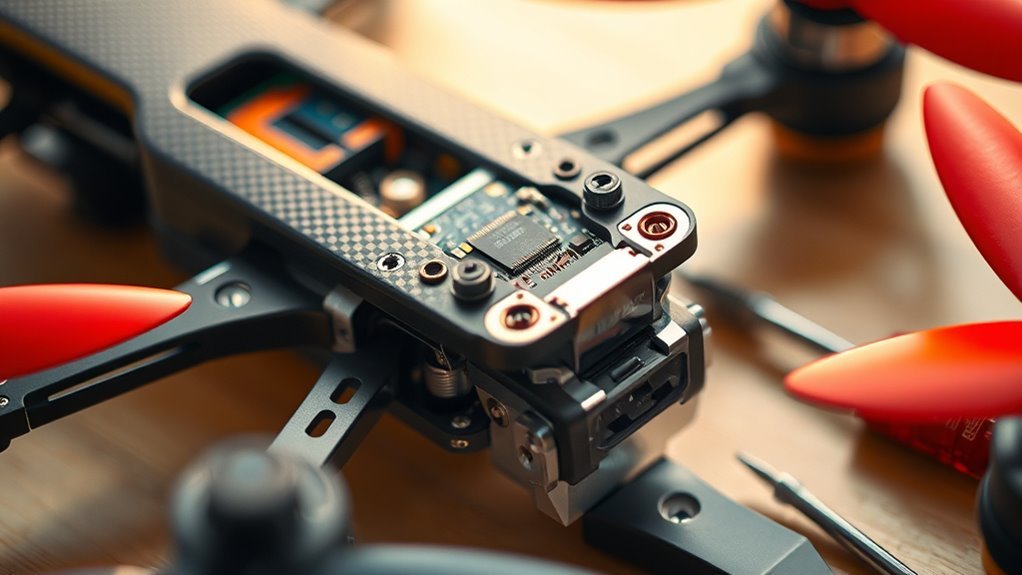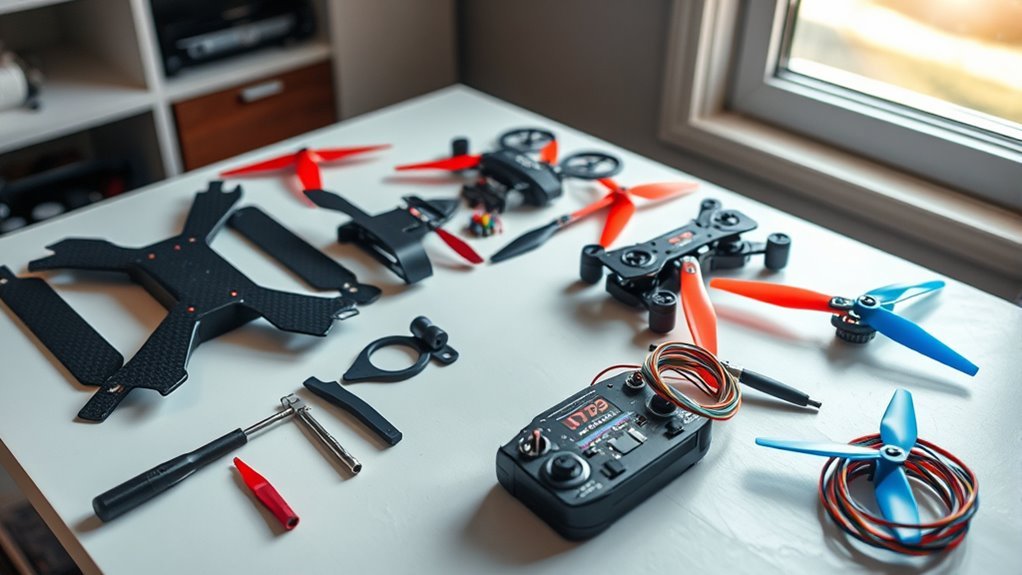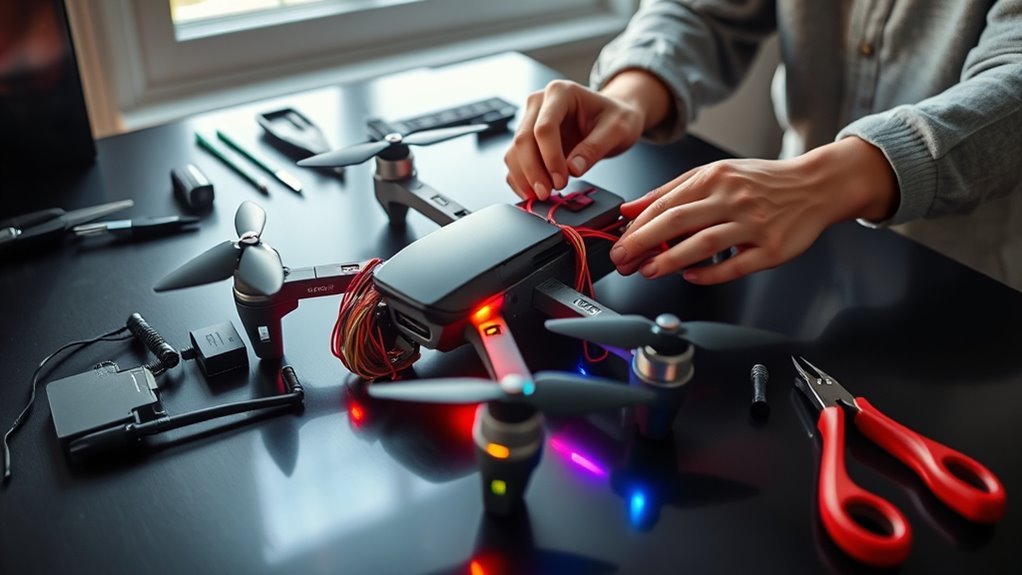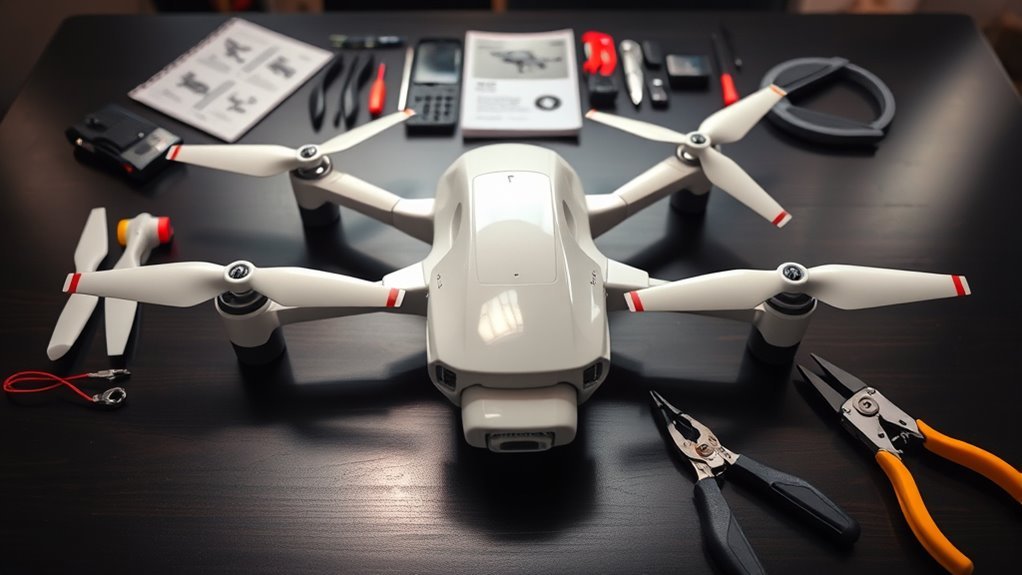To assemble a drone, start by understanding its components, like the frame, motors, ESCs, and flight controller. Gather essential tools, including screwdrivers, a soldering iron, pliers, tweezers, and a multimeter. Follow a step-by-step process: secure the frame, attach the motors, wire the ESCs, and fix the propellers. Don’t forget to configure flight settings and conduct safety checks before flying. For detailed guidance on each step and tips, continue exploring more resources.
Understanding Drone Components

To successfully assemble a drone, it’s essential to understand its key components. First, identify the drone types you’ll work with; each has distinct component functions. The frame supports all other parts and determines the drone’s size and weight. Motors provide thrust, while electronic speed controllers (ESCs) regulate motor speed, vital for stability. The flight controller acts as the brain, processing sensor data to maintain balance. Batteries supply power, impacting flight time and performance; for instance, the DJI Mini 3 offers up to 38 minutes of flight time, enhancing its usability for extended tasks. Propellers convert motor rotation into lift, directly affecting maneuverability. Finally, consider the transmitter and receiver for remote control. Understanding these components enables you to make informed choices and modifications, empowering your flight experience while ensuring your drone operates safely and efficiently. Additionally, consider how flight time and battery performance can influence your choice of drone and its intended use.
Essential Tools for Assembly

While assembling a drone, having the right tools on hand is vital for a smooth process. Start with a quality screwdriver set that includes various screw types—Phillips, flathead, and hex—to guarantee you can handle any fastener. A soldering iron is essential for making secure electrical connections; learn soldering techniques to join wires effectively without damaging components. Pliers and wire cutters will help in managing and trimming wires, while tweezers are useful for handling small parts. Don’t forget a multimeter for testing connections and verifying everything operates correctly. Finally, a workbench or mat will keep your workspace organized and prevent losing tiny components. Equip yourself with these tools to embrace the freedom of building your custom drone.
Step-by-Step Assembly Process

Assembling a drone involves several critical steps that require attention to detail and precision. To master drone technology, follow these assembly techniques:
- Frame Assembly: Begin by connecting the frame components, ensuring all joints are secure.
- Motor Installation: Attach the motors to the designated mounts, making sure they’re oriented correctly for peak performance.
- Wiring Connections: Carefully connect the ESCs (Electronic Speed Controllers) to the motors and flight controller, ensuring no loose wires.
- Propeller Attachment: Finally, secure the propellers onto the motors, double-checking for proper rotation direction.
Configuring Your Drone for Flight
Before your drone takes to the skies, configuring it for flight is essential to guarantee peak performance and safety. Start by selecting the appropriate flight modes based on your skill level and the intended use. Beginner modes often limit speed and altitude, while advanced modes allow for full control and agility. Next, implement calibration techniques, ensuring the compass and gyroscope are properly aligned. This step minimizes flight errors and enhances stability. Use the drone’s app or controller settings to execute the calibration process, following on-screen instructions carefully. Additionally, consider the flight time of your drone model to plan your flying sessions effectively. A drone’s intuitive controls can significantly aid beginners in mastering flight basics. Finally, conduct a pre-flight check to confirm all systems are operational. With these configurations complete, you’re ready to embrace the freedom of flight, equipped for an exhilarating experience.
Safety Tips and Best Practices
To guarantee a safe flying experience, it’s essential to adhere to established safety tips and best practices. Ignoring these could lead to accidents or legal issues. Follow these guidelines for a smooth operation:
Adhering to safety tips is crucial for a smooth flying experience and to avoid accidents or legal complications.
- Check Battery Safety: Always inspect your drone’s batteries for damage and verify they’re fully charged before flight. Additionally, be aware that battery life can significantly impact your drone’s operational range and safety.
- Know Flight Regulations: Familiarize yourself with local laws regarding drone operation; respect no-fly zones and altitude limits.
- Pre-Flight Checklist: Conduct a thorough pre-flight inspection of your drone, checking for loose components or software updates.
- Maintain Line of Sight: Keep your drone within visual range at all times to confirm you can react quickly to any potential hazards. Additionally, be aware of no-fly zones in your area to avoid any legal complications.
Frequently Asked Questions
Cuánto Tiempo Tarda En Ensamblarse Un Dron Promedio?
The average time for assembling a drone typically ranges from one to three hours. With practice, you can achieve an ensamblaje rápido, often reducing that tiempo estimado considerably, allowing for more flight time and exploration.
Puedo Usar Piezas De Diferentes Marcas En Un Dron?
Yes, you can use parts from different brands, but guarantee their compatibility. It’s essential to check specifications and reviews for recommended brands to avoid performance issues. Mixing components can offer flexibility, enhancing your drone’s capabilities effectively.
Qué Tipo De Batería Es Mejor Para Mi Dron?
When choosing a battery for your drone, consider a batería de polímero with a high capacidad de descarga. This combination guarantees peak performance, offering you the freedom to fly longer and more efficiently during your adventures.
Es Legal Volar Drones En Mi Área?
Did you know that over 60% of drone operators unknowingly violate local regulations? To fly legally, check your area’s local regulations and avoid restricted zones to maintain your freedom while flying safely and responsibly.
Dónde Puedo Encontrar Repuestos Para Mi Dron?
To find drone parts, you should check specialized stores or consider online shopping. Many retailers offer a variety of components, ensuring you can maintain and upgrade your drone for peak performance and freedom in flying.

